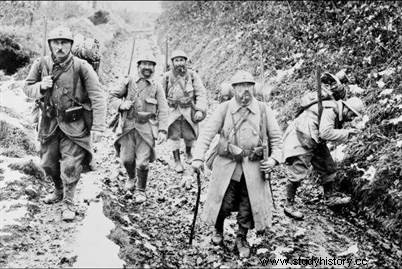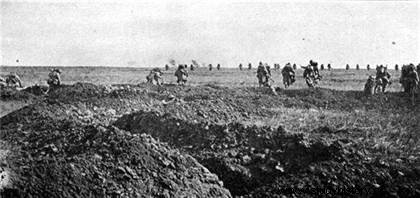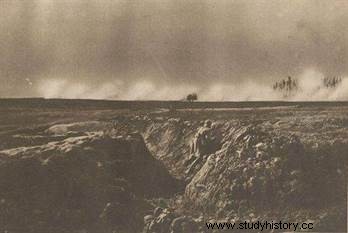 Named in honor of Adelaide and Victoire, daughters of Louis XV, the "Chemin des Ladies “, also called “battle of the Aisne” or “Nivelle offensive”, was above all a huge battle of the First World War. It was on this limestone plateau that General Nivelle , commander-in-chief of the French armies, chose to focus his efforts, mobilizing a million men to break through the German lines. The generalissimo wants to be confident:“ the time has come, confidence, courage and Long live France! However, the Chemin des Dames offensive turned into a fiasco and cost Nivelle his command, replaced by Pétain. She will be largely responsible for the mutinies of 1917.
Named in honor of Adelaide and Victoire, daughters of Louis XV, the "Chemin des Ladies “, also called “battle of the Aisne” or “Nivelle offensive”, was above all a huge battle of the First World War. It was on this limestone plateau that General Nivelle , commander-in-chief of the French armies, chose to focus his efforts, mobilizing a million men to break through the German lines. The generalissimo wants to be confident:“ the time has come, confidence, courage and Long live France! However, the Chemin des Dames offensive turned into a fiasco and cost Nivelle his command, replaced by Pétain. She will be largely responsible for the mutinies of 1917.
The Chemin des Dames:a symbol of hope project
The war had been going on for more than two and a half years and the situation in France was worrying. While its American ally did not yet have a real army, the French government saw Russia in the midst of a revolution giving up the fight. Morale both at the front and rear of the front was at half mast when it was not downright clouded or shaken. Robert Nivelle, a simple colonel commanding an artillery group in 1914, quickly rose through the ranks of the military hierarchy thanks to his great feats of arms.
 He distinguished himself in particular at Verdun in 1916. Charismatic, naturally optimistic and confident, he was chosen to succeed Joffre at the head of the armies in December 1916. He carried with him a daring plan aimed at ending the war. With a numerical superiority on the western front, Nivelle wanted to strike as quickly as possible. He wanted to break the front of brutal and massive matter in particular thanks to a new weapon:the tank. He was looking to break through, advancing under the protection of rolling fire to destroy the German artillery and supply lines.
He distinguished himself in particular at Verdun in 1916. Charismatic, naturally optimistic and confident, he was chosen to succeed Joffre at the head of the armies in December 1916. He carried with him a daring plan aimed at ending the war. With a numerical superiority on the western front, Nivelle wanted to strike as quickly as possible. He wanted to break the front of brutal and massive matter in particular thanks to a new weapon:the tank. He was looking to break through, advancing under the protection of rolling fire to destroy the German artillery and supply lines.
General Nivelle, confident in the numerical superiority of the Allies, therefore decided on a major offensive in order to break through the German lines. His plan provides for a first Franco-British offensive in Artois which would aim to fix a large part of the German forces. But the main attack would actually take place in the Aisne, the objective being to seize the Chemin des Dames, a ridge road between the Aisne and Ailette rivers.
A badly launched offensive
 After the armies of Generals Micheler and Mangin broke through the lines, and heavy artillery destroyed the German rear several kilometers deep, a French army held until then in reserve, will exploit the breakthrough. However, even before the offensive was launched, two events jeopardized its success. In fact, on March 16, General Ludendorff decided to shorten the German front and pushed his troops back about forty kilometres, thus completely modifying the planned assault terrain. Moreover, a number of French generals, such as Pétain, and politicians, did not believe in this plan and contributed to weakening Nivelle's position. But the decision to launch the offensive is nevertheless maintained.
After the armies of Generals Micheler and Mangin broke through the lines, and heavy artillery destroyed the German rear several kilometers deep, a French army held until then in reserve, will exploit the breakthrough. However, even before the offensive was launched, two events jeopardized its success. In fact, on March 16, General Ludendorff decided to shorten the German front and pushed his troops back about forty kilometres, thus completely modifying the planned assault terrain. Moreover, a number of French generals, such as Pétain, and politicians, did not believe in this plan and contributed to weakening Nivelle's position. But the decision to launch the offensive is nevertheless maintained.
The plan for this offensive, which was to break the front of a German army that was thought to be exhausted after the bloodletting of Verdun, was altogether classic. After intense artillery preparation, the forces concentrated in a space of 30 km must break through the enemy lines and advance under the protection of rolling fire. The exploitation is entrusted to an army abundantly provided with cavalry troops. From the start, the success of such a plan is compromised. The German army is perfectly aware of the French intentions and enjoys excellent defensive positions since holding the slopes and overlooking the French units. On the other hand, the overcast weather made the planning of the artillery preparation hazardous, which turned out to be much less effective than expected.
The Battle of the Chemin des Dames
It all started after two assaults led on April 9 by the English army and then on April 12 by the French army to assess the resistance of the enemy who was thought to be exhausted after the Battle of Verdun. A major offensive was being prepared between the Oise and the Montagne de Reims, mainly on the heights of the Chemin des Dames. The long preparations of the French artillery gave the German army every opportunity to reinforce itself, especially since it had been informed of part of Nivelle's plans. It was planned to attack in good weather. However, it was the cold, the fog and the mud which predominated the morning of April 16, 1917. Against all odds, the assault was launched at 6 am. The infantry and cavalry of the 5th and 6th armies had to cross the Aisne, climb the slope of the Chemin des Dames then cross the plateau to descend from the north and reach the valley of the Ailette. The French General Staff expected to bring its troops to the vicinity of Laon, cutting off the German supply routes between Reims and Soisson.
 Facing a well-prepared German army, high up in a maze of galleries and caverns, and facing in weather conditions hampering the adjustments of the artillery and the movement of the troops, the first day of combat ended in an advance of 500 meters instead of the expected 10 kilometers. Only 10,000 prisoners instead of the estimated 100,000. At the end of this first day, Nivelle became aware of the failure of his strategy, the breakthrough sought would not succeed. But he still wanted to take the Chemin des Dames and sent the 10th Army as reinforcements. Despite the opprobrium of public opinion, he unsuccessfully continued operations until May 9.
Facing a well-prepared German army, high up in a maze of galleries and caverns, and facing in weather conditions hampering the adjustments of the artillery and the movement of the troops, the first day of combat ended in an advance of 500 meters instead of the expected 10 kilometers. Only 10,000 prisoners instead of the estimated 100,000. At the end of this first day, Nivelle became aware of the failure of his strategy, the breakthrough sought would not succeed. But he still wanted to take the Chemin des Dames and sent the 10th Army as reinforcements. Despite the opprobrium of public opinion, he unsuccessfully continued operations until May 9.
A fatal toll
In fifteen days, the French army counted some 40,000 dead and 90,000 wounded, not to mention prisoners and missing. Without reaching the atrocious figures of Verdun, it was too much for public opinion and for the soldiers. The great movement of hope that Nivelle had aroused had turned into total disillusion, provoking a terrible political, social and, above all, military crisis. Indeed, the mutinies were the immediate consequence of this defeat. At least Pétain, who replaced Nivelle at the head of the armies, no longer launched (or dared to launch) his troops blindly on the attack unless he had absolute superiority in equipment. Unfortunately, this was not the case with the British army, which needlessly sacrificed several hundred thousand men at the battle of Passchendaele in the autumn of 1917.
And whether alongside Passchendaele, Verdun or the Battle of the Somme, the Chemin des Dames remains one of the most tragic episodes of the Great War.
Bibliography
- Le chemin des Dames:Spring 1917, by Yves Buffetaut. Ysec Editions, 2017.
- The ladies' path, by Pierre Miquel. Found Editions, 2018.
- Le chemin des Dames, from event to memory, Éditions Stock, Paris, 2004.
